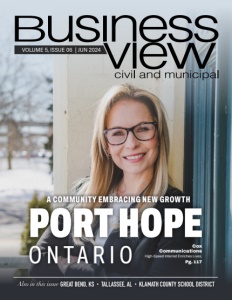The Huron-Superior Catholic District School Board (H-SCDSB)
Shaping Tomorrow’s Student Success
Providing the right mix of technical and academic focus so students are ready to meet the future head-on
The Huron-Superior Catholic District School Board (H-SCDSB) is a vast educational entity that extends its reach over an impressive geographical area, ranking among the largest school boards in North America. Encompassing over 40,000 square kilometers and stretching 800 kilometers from one school to another, this district is dedicated to serving diverse communities with unique needs and characteristics, demonstrating a strong commitment to equity and inclusivity.
Leadership and vision
Danny Viotto, the Director of Education; Gary Trembinski, the Chair of the Board of Trustees; and Jim Fitzpatrick, Communications Officer, collectively bring expertise to the district’s operations. Their insights on the district’s challenges and successes in serving a diverse and expansive community across Northern Ontario underscore its educational equity and quality commitment.
Adaptive education
The central administration office is in Sault Ste. Marie, Ontario. From here, the school board extends its reach to various small, remote communities to the north and east. Notable northern communities include Hornepayne, White River, Wawa, and Chapleau, with unique mining and forestry industries and diverse populations.
Moving eastward, the district serves communities like Elliot Lake, now a retirement haven with a population between 12,000 and 15,000. Blind River, located on the shore of Lake Huron, is another key community with approximately 5,000 residents. Smaller towns like Massey and Espanola also fall under the district’s jurisdiction.
The board operates seven elementary schools in Sault Ste. Marie, the largest of which enrolls nearly 800 students. However, the district’s adaptability shines in its smaller schools in remote communities, like those in Hornepayne or Massey. These schools, with student populations between 80 and 150, demonstrate the district’s commitment to providing quality education to all, regardless of community size.
Equitable access and community engagement
The board also includes a high school and an adult learning center in Sault Ste. Marie to address the educational needs of a diverse student body. The adult learning center is crucial in supporting newcomers to Canada and adults seeking to complete their high school education or gain additional skills necessary for employment.
Ensuring equitable access to educational resources across such a varied district is a significant challenge. However, H-SCDSB is committed to this goal through several strategic approaches. Trustees from various regions provide representation and advocacy at the board level, ensuring that the unique needs of each community are voiced and addressed. Superintendents work closely with school principals to tailor solutions for each school’s unique context.
“Listening to our communities and responding authentically to their needs is essential for our growth and success,” says Viotto.

Infrastructure and funding
School funding is allocated based on student populations, with government grants ensuring that resources are distributed fairly. Regardless of location, classrooms in the districts are designed to provide a consistent and high-quality learning environment, ensuring that students in remote areas like Hornepayne receive the same educational experience as those in larger centers like Sault Ste. Marie.
Viotto elaborates on the impact of infrastructure upgrades, emphasizing that ensuring physically safe student environments is paramount. He highlights the importance of HVAC systems and air quality, with regular testing conducted across all schools.
Trembinski adds that the district has proactively addressed school closures and amalgamations, recognizing the cost inefficiencies of maintaining neighborhood schools. This initiative, though initially unpopular, has since been widely accepted. For example, in Sault Ste. Marie, four schools were amalgamated into one large school, enabling the creation of more extracurricular programs, such as sports teams, that smaller schools couldn’t support. Some closed school properties have been sold and converted into affordable housing, benefiting the broader community.
The board’s proactive approach extends to dealing with dilapidated infrastructure in areas like Elliott Lake and Espanola, where funding was secured after prolonged efforts, resulting in significant school upgrades. One notable project involved a partnership with the French Catholic Board in constructing a joint school facility, a $25.2M project showcasing successful inter-district collaboration. Such partnerships have led to increased enrollment and improved facilities in these regions.
STEAM and technological integration
Fitzpatrick focuses on the board’s commitment to community partnerships and innovative programs. He details the creation of a STEAM (Science, Technology, Engineering, Arts, and Math) Lab supported by Tenaris, which provides financial backing. The lab serves as a centralized resource for students from various schools to engage in hands-on learning, addressing the challenge of integrating STEAM education across all classrooms due to resource limitations.
“Our STEAM Lab has revolutionized how we approach science and technology education,” Fitzpatrick states. “It provides students with access to resources and learning experiences that were previously unavailable.”
Viotto stresses the board’s comprehensive approach to integrating technology in classrooms. All schools have Chromebooks, ensuring every student can access this essential tool. Teachers are provided with laptops, enhancing their ability to deliver engaging and interactive lessons. Classrooms are outfitted with projectors, smart boards, and touch screens, further supporting a dynamic learning environment.
The board recognizes the unique needs of younger students, providing tablets to junior kindergarten, senior kindergarten, and grade one students. The tablets facilitate touch learning, which is more suitable for younger children. The focus on technology isn’t new but rather the result of years of dedicated effort to build an extensive IT infrastructure. The commitment necessitated an expansion of the IT department to support the increased demand for technological integration.
Indigenous partnerships and cultural integration
H-SCDSB has also made significant strides in promoting Indigenous education and cultural awareness. The Indigenous Learning Department has expanded, fostering connections with local First Nations and embedding Indigenous culture and traditions into the curriculum. The initiative includes land-based learning programs at the St. Kateri Outdoor Learning Center, where students participate in a hybrid classroom and outdoor education model, integrating Indigenous perspectives into their learning experience.

Strategic priorities and goals
Looking ahead, the Huron-Superior Catholic District School Board (H-SCDSB) is committed to several key priorities and goals that will shape its future. Viotto emphasizes that the district’s multi-year strategic plan remains anchored in Catholic principles and values.
A primary priority is maintaining communication channels with students, families, and staff to understand and respond to their evolving needs. By actively listening to feedback from these key stakeholders, the district can tailor its programs and initiatives to remain relevant and effective.
H-SCDSB also places significant emphasis on fostering partnerships, particularly as the community experiences an influx of newcomers. This includes partnerships with local organizations such as the Sault Community Career Center and Sault College, which provide essential services and integration support for newcomer families.
Furthermore, the board continues to strengthen its relationships with First Nations communities. Regular meetings with First Nations representatives help the district understand and address the communities’ unique educational needs.
“Integrating Indigenous culture into our curriculum has enriched our educational programs and fostered a greater understanding and respect among our students,” adds Viotto.
The emphasis on STEAM education and Indigenous partnerships showcases its innovative approach to curriculum development. By integrating these elements into the educational experience, the board enhances student engagement and learning outcomes and promotes cultural awareness and appreciation.
Embracing diversity and inclusion
As the Huron-Superior Catholic District School Board looks to the future, it remains committed to embracing diversity and fostering an inclusive environment. The board’s efforts to support multilingual learners and newcomers reflect its dedication to ensuring that every student feels welcomed and valued.
The district’s initiatives in Indigenous education further demonstrate its commitment to inclusivity. By incorporating Indigenous perspectives and traditions into the curriculum, the district provides students with a more comprehensive and enriching educational experience. This approach fosters mutual respect and understanding, laying the groundwork for a more inclusive and harmonious community.
AT A GLANCE
The Huron-Superior Catholic District School Board (H-SCDSB)
What: The Huron-Superior Catholic District School Board (H-SCDSB) is a school board in Ontario, Canada, responsible for administering Catholic education where students can grow academically, spiritually, and personally.
Where: Administrative offices are based in Sault Ste. Marie, Ontario, Canada.
Website: https://www.hscdsb.on.ca/




